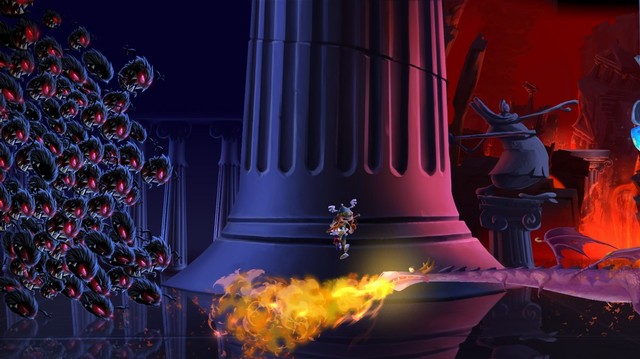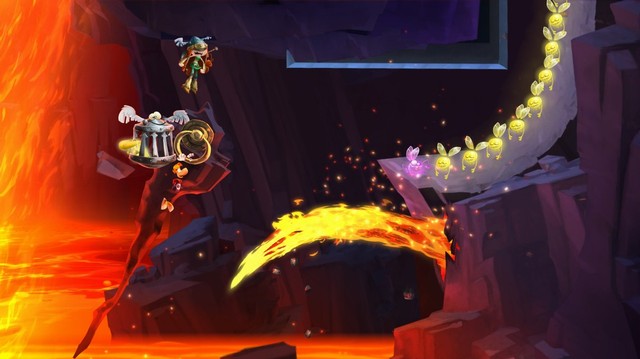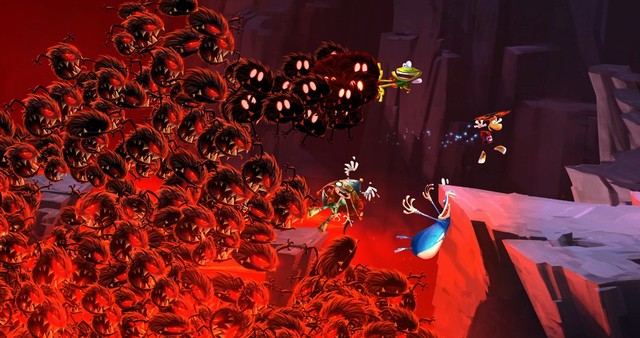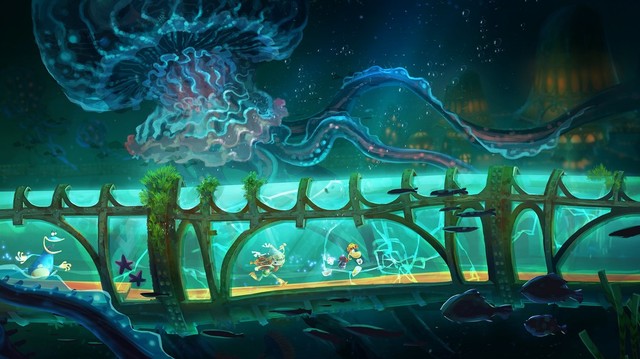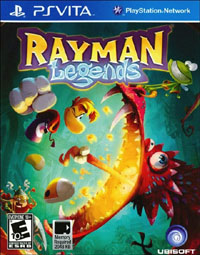If you haven’t bought a PlayStation Vita yet then I have two words for you; RAYMAN LEGENDS. Yes, if all the PS4 integration news and Sony’s recent price drop wasn’t enough to pry a pair of Ben Franklins out of your wallet then perhaps Ubisoft’s latest masterpiece will do the trick. Rayman Legends is, without a doubt, one of the absolute best games available on the Vita and in my opinion; a system seller title that not only makes the most out of the hardware but also appeals to the pick-up-and-play nature of portable gaming.
For the past week I’ve been playing this game whenever and wherever possible. One time I tried to sneak in a level during a TV commercial and ended up hitting pause on the DVR when the show started back up so I could keep playing the game. It wasn’t until 60 minutes later when the DVR buffer was full and the show resumed that I snapped back into the real world. Yes – 60 minutes of Rayman Legends can take place in what seems like a 60 second commercial break. You WILL lose yourself to this game, and I literally had to tear myself away to write this review…well, that and my battery finally died – pretty much the only reason I ever stop playing.
So what makes this game so darn addicting? First, the graphics are simply out of this world; some of the best and most colorful I’ve ever seen on the Vita. It’s enough to tempt me to play the game on console or PC just to experience on a bigger screen, but the gameplay is so perfectly tuned for the Vita and its touch/tilt controls I wouldn’t want to sacrifice the gameplay nuances.

The game menu is setup as a series of art galleries that you can walk Rayman (or whatever unlocked character model you are using) around, jumping into any available painting to enter a new gallery specific to a new world of gameplay or options. There is a Creatures Gallery where you can view any unlocked creatures and collect your daily allowance of coins and Lums. Back to Origins is a secondary gallery with five paintings, each leading to their own gallery with eight playable levels in those that must also be unlocked. With all of the nested galleries and paintings it can be easy to get lost in the sheer amount of content, but the magic of the design is that there is no required order in which to play any of it. In fact, as you play and unlock material the game offers to take you to that new content with a tap of the screen, so you can essentially just go along for the ride. Only compulsive gamers who feel the need to complete each painting and gallery before proceeding to the next will never need to wander the interactive gallery menus.
Also found in the main gallery is Kung Foot, a multiplayer-only mini-game that has each player trying to jump and kick a soccer ball into the other team’s goal. It’s simple, intense, and extremely fun. Next is Murfy’s Challenges. In these levels you take control of the environment by tapping and swiping the screen to interact with obstacles and creatures in order to get Globox safely to the end and collect any Teensies along the way. This is pretty much the Player 2 experience if you play co-op. The Heroes gallery has painting of all the unlocked characters from the game and jumping into any of those switches the main character. It’s a visual swap only, and I saw no difference in the way the game played.
The rest of the paintings in the Main Gallery are dedicated to the new worlds and levels in Rayman Legends. Teensies in Trouble, Toad Story, Fiesta de los Muertos, 20,000 Lums Under the Sea, Olympus Maximus, and Living Dead Party are loaded with amazing new levels that will divert you from all other aspects of your life. Naturally, a lot of the game is locked down but unlocking new content is fairly easy, either by collecting the requisite amount of Lums (which are tallied across all levels), or scratching away at lotto tickets awarded after each level. These tickets are your key to unlocking creatures, Back to Origins levels, and bonus Lums and Teensies.

Gameplay is traditional sidescrolling platform style, at least on the surface. Along the way you will be required to tap the screen to interact with objects like doing an upward swipe to uproot a plant or tickle a mini-boss to get past him. You can tap and drag over streams of Lums to turn them pink and increase their value and there is even a touch and drag slingshot you can use to shoot down dragons. There are also moments where you will lock the environment and rotate your Vita to spin objects within the level in order to proceed. It is some of the best and most seamlessly integrated touch controls of any Vita game to date.
Rayman Legends is so much fun you will certainly want to share the experience, not just with the optional Facebook connect feature that lets you share stats and participate in daily and weekly challenges, but also in two-player action over local ad hoc or Wi-Fi. In addition to competitive games like Kung Foot, you can also play all 90 levels in the game cooperatively. Player two is mostly regulated to interacting with the environments; turning Lums pink, dragging coins into a better pick-up position, or cutting ropes, but it is still a lot of fun and a great way to boost your score.
Hooking up with a friend was no problem in my local couch co-op sessions. My only quibble was that there was no easy way to replay a level, performing the actions and duties of the second player without disconnecting and letting the other player become the host. Sure, you can swap Vita’s but only the host player is earning Trophies (if that’s important to you). It would have been nice to choose your role in a two-player game regardless of who was hosting.

As previously mentioned, the graphics are some of the best in platform gaming and certainly the best the Vita has ever seen when it comes to original art design, colors, and fluid animation. Rayman Legends is simply a work of art – no pun intended, and the soundtrack only enhances the experience. From the jazzy themes in the gallery menus complete with whistle solos to the interactive music in the main game, each track fits the level perfectly in theme and on-screen intensity. You have whimsical tunes for the more adventurous and exploratory levels and then these raging bass beat orchestrations for action sequences and boss fights, but one only need look (or listen) as far as the Castle Rock level to experience the sheer magnitude of creative inspiration in Rayman Legends’ sound design. In this level the hard rockin’ music (Black Betty) not only drives the action and momentum of your gameplay, but your interactions also help to perform the soundtrack by adding in notes and instrumentation of your own in real-time. That, along with the creatures singing the unintelligible lyrics like demented chipmunks is pure genius.
Rayman Legends offers an unprecedented amount of entertainment for a handheld game. Not only do you get everything the console versions offer, but there is Vita-exclusive content as well. I could go on and on about how awesome Rayman Legends is on the PS Vita but frankly, I’d rather be playing it than writing about it, and if I haven’t convinced you to buy a copy by now you are beyond hope. For the rest of you, I’ll see you on the leaderboards…hopefully somewhere below me.


